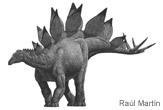
A Stegosaurus fossil has been discovered in Europe, marking the first time the famous plated dinosaur has been found outside of North America.
The find supports a widely accepted idea that the two continents were once connected by a series of temporary land bridges which surfaced when sea levels dipped, allowing dinosaurs to cross.
“Both coasts were very close and the basins between them could emerge occasionally,” said study leader Fernando Escaso of the Autonomous University of Madrid, Spain.
During the first half of dinosaurs’ 185-million-year reign on Earth, all of the world’s continents were clumped together into one giant landmass called Pangaea. At the end of the Jurassic Period, about 150 million years ago, the supercontinent began slowly splintering: North America, Europe and Africa began to drift apart, and in the widening rift between them, the Atlantic Ocean was born.
At times during this million-years long transformation, sea levels rose and fell, and land bridges occasionally emerged between the newly sundered landmasses. During times of connectedness, dinosaurs like Stegosaurus [image] would have been able to cross.
Stegosaurus
Well-known to any dinosaur enthusiast, Stegosaurus was a bizarre looking herbivorous creature that had a back adorned by a double row of vertical plates and a tail studded with spikes. It was once thought these strange accessories were for protection or used to radiate heat from the dinosaur’s body. But now most scientists think the body armor was probably just extreme example of the elaborate and colorful displays animals use to recognize each other as the same species.
Get the world’s most fascinating discoveries delivered straight to your inbox.
The scientists unearthed the new Stegosaurus fossils—which included a tooth and parts of the animal’s spinal column and leg bones—near the city of Batalha, in central Portugal. Preliminary analyses show the fossils to be indistinguishable from a species previously found only in North America, called Stegosaurus ungulatus.
While the similarity bolsters the land-bridge case, it provides no information on the distribution and duration of those bridges [image].
“At present, it isn’t possible to know the structure, frequency and duration of these land bridges,” Escaso told LiveScience.
Bridging continents
Peter Makovicky, a paleontologist at the Field Museum in Chicago who was not involved in the study, said the new Stegosaurus discovery supports something largely suspected in the past and helps flesh out some of the geological history of the region.
“It documents the second genus of dinosaurs that’s well-known from the Jurassic of North America to be present in Europe, and thereby gives evidence that there was a fairly strong connection between these areas during that time,” Makovicky said in a telephone interview.
The only other dinosaur for which bones have been found in both North America and Europe is a species of Allosaurus, a large meat-eating dinosaur similar to Tyrannosaurus rex, but without the latter’s stubby meat-fork arms.
The new finding will be detailed in an upcoming issue of the German science journal Naturwissenchaften.
- Images: Dinosaur Art
- Images: Drawing Dinosaurs
- Scientists Debate Dinosaur Demise
- Birds of Prey: Spot Today's Dinosaurs
- A Brief History of Dinosaurs
- Images: Dinosaur Fossils
- All About Dinosaurs
Pangea
Pangea began to break up about 225-200 million years ago. This animation shows how it unfolded.
SOURCE: USGS



